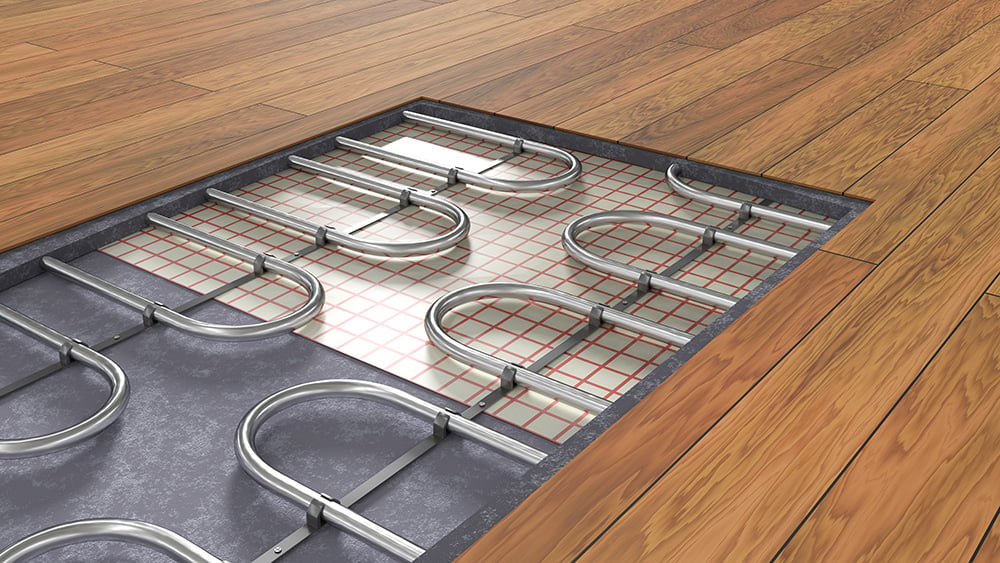
If you're a building owner or manager, you have to make tough calls when it comes to commercial HVAC. You can choose so many options to heat and cool your building, including radiant and forced-air systems.
Each system has a large impact on utility costs and the comfort level of your occupants. That's why Warner Service helps you choose which heating system is right for your commercial building.
Radiant Heating
Records show that underfloor radiant heating dates back to ancient Rome. Even Benjamin Franklin used it in one of his inventions. These systems have proven through the years to be an effective method of heating spaces, and it's enjoying a recent resurgence.
Radiant heating heats everything in a space. It warms the air and the floor, and then that heat is transferred to whatever touches the floor. It’s like standing next to a window on a winter day with the sunlight streaming in. You’re warmed by the sun’s radiant heat, rather than the air in the room around you.
Today, the most common radiant systems are hydronic. In these heating systems, water passes through a high-efficiency boiler and is heated to about 110 degrees Fahrenheit. It's then circulated through tubing under the subfloor. That hot energy from the water then heats the tubes. These tubes heat the floor and subsequently the rest of the room.
Once the floor heats to operating temperature, it functions as a thermal mass. This "mass" emits heat between the on/off cycles of the boiler that heats the circulating water. This effect smoothes out the uncomfortable temperature fluctuations of an on/off forced-air system cycle.
This method of heat transfer is extremely efficient because it's easier for water and objects to heat the air than for air to heat objects (or people).
Another benefit of this heating method is heat energy in hot air transmits through glass windows on a cold day. The electromagnetic energy of radiant heat reflects off windows and remains indoors.
Forced-Air Heating
Forced-air uses electric-powered blowers to move air precisely and at will. This heating system is inexpensive and more versatile than radiant systems.
For example, the ductwork in a forced-air system can also be used in the summer for air conditioning. Also, air filters are installed to improve the indoor air quality in a commercial building.
In a common gas-fired forced-air heating system, air is pulled out of rooms through return ducts by the suction of the blower fan. As the air is pulled, it's heated and drawn over the heat exchanger inside the furnace. This heated air is then distributed through supply ducts to warm every room in the building.
Conclusion
-
Radiant heat warms the room at the level where people work. Heated air from a forced-air furnace duct quickly rises up and often out of the room. The thermostat for a radiant system can be set up to 8 degrees lower than the thermostat for a forced-air system without a difference in comfort level.
-
Radiant heat requires no blower or other air circulation to create a warm building. This draft-free performance reduces the level of allergens and pathogens. This improves indoor air quality.
-
The rumbling noise of air through ductwork is a hallmark of the forced-air furnace. A radiant system is completely silent.
-
Mass production of furnaces and ductwork combined with fine-tuned installation practices lower the upfront costs of using forced-air heat. This makes it the most economical option.
-
Ductwork used to convey heat throughout a building in the winter can also convey central air conditioning in the summer. Today’s central heating furnaces often include an A/C evaporator coil and condensation collection equipment. These components can be incorporated into a central air conditioning system. Consolidating both systems is space-saving and cost-efficient.
-
Forced-air heating and cooling systems maintain healthy indoor air quality. Because these units circulate air through a filter, the air is filtered several times daily. The whole-building air circulation of a forced-air system can also be treated by a humidifier.
For more information on how to save energy in your commercial building, click on the button below: 

